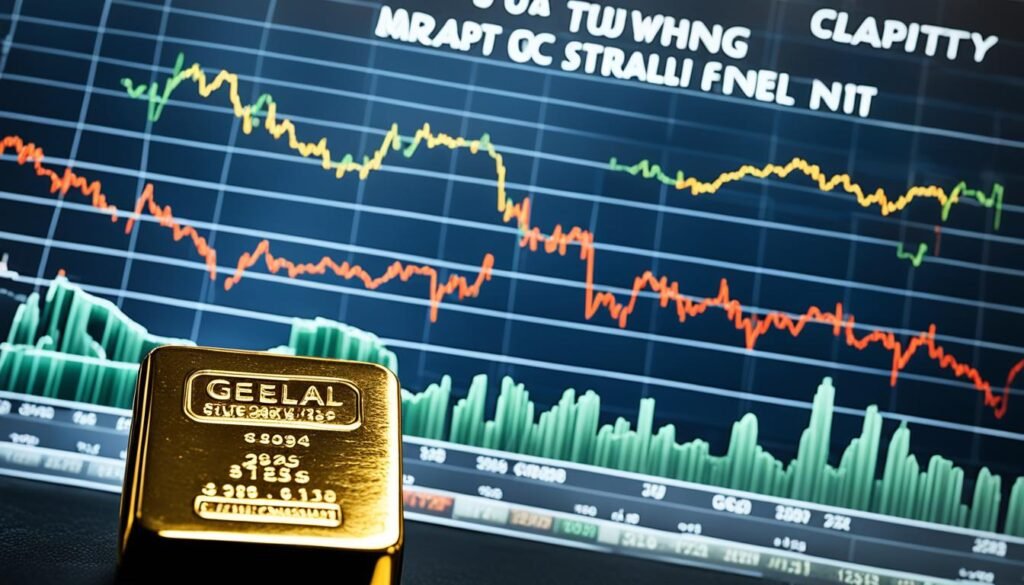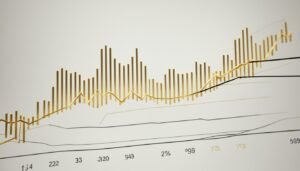When it comes to protecting your investments against inflation, two assets have emerged as popular choices: gold and cryptocurrency.
But which one reigns supreme?
Are the glittering properties of gold enough to outshine the rising influence of crypto? Or does the digital revolution of cryptocurrency offer a more effective inflation hedge?
Prepare to delve into the fascinating world of gold versus crypto as we compare these two powerhouses in the investment landscape.
Key Takeaways:
- Gold and cryptocurrency are both considered as potential inflation hedges, but their characteristics and dynamics differ significantly.
- Gold has traditionally been viewed as a safe haven asset, maintaining value during market downturns and economic crises.
- Cryptocurrency, led by Bitcoin, has gained recognition as an innovative contender in the world of inflation hedging.
- Understanding the regulatory landscapes and practical uses of gold and crypto is crucial for investors.
- Assessing your investment between gold and crypto requires a deep understanding of rarity, volatility, and investment appeal.
Understanding Inflation Hedges: Gold and Crypto in Focus
In today’s uncertain economic climate, investors are increasingly turning to inflation hedges to protect their portfolios against the eroding effects of rising prices. Two popular assets that have gained recognition as potential inflation hedges are gold and cryptocurrency.
Gold has long been regarded as a traditional store of value, prized for its inherent scarcity and durability. Over centuries, gold has proven to be a reliable hedge against inflation, preserving wealth when paper currencies lose purchasing power. Its tangible nature, global acceptance, and historical track record make it a sought-after asset during times of economic uncertainty.
Cryptocurrency, on the other hand, is a relatively new entrant in the world of inflation hedges. As a digital or virtual currency, cryptocurrencies like Bitcoin offer unique advantages. They operate on decentralized blockchain technology, providing security, transparency, and potential anonymity. Cryptocurrencies are not subject to government control or intervention, making them resistant to inflation pressures.
Both gold and cryptocurrency have their own distinct characteristics and features that attract investors seeking a hedge against inflation:
- Gold: As a physical asset, gold offers tangibility and a long-standing reputation for preserving wealth. Its limited supply and global appeal contribute to its price stability during economic downturns. Additionally, gold’s wide acceptance in jewelry, industry, and central bank reserves adds to its overall demand and value.
- Cryptocurrency: The decentralized nature of cryptocurrencies allows for easy global transfers and transactions, making them highly accessible investments. Their limited supply, coded scarcity, and increasing adoption contribute to their potential as inflation hedges. Additionally, the growing interest from institutional investors and financial institutions has further legitimized cryptocurrencies as a viable asset class.
While there are similarities between gold and cryptocurrency as inflation hedges, it is important to note that they also have notable differences. Gold has stood the test of time and has a well-established market, while cryptocurrencies are still in the early stages of adoption and face volatility due to their relatively nascent development.
As the demand for inflation hedges continues to rise, understanding the dynamics of gold and cryptocurrency as potential options becomes crucial for investors. The following sections will explore the specific attributes and performance of both assets to provide readers with a comprehensive understanding of their investment potential.
The Enduring Value of Gold During Market Downturns
In times of uncertainty and market volatility, investors often seek safe haven assets to protect their wealth. Gold, with its long history as a store of value, has proven to be a reliable choice during market downturns. This section explores the performance of gold during recessions and highlights its comparative stability as an investment.
Gold’s Performance in the Face of Recession
During economic recessions, gold has consistently demonstrated its ability to maintain value and even appreciate in price. The allure of gold as a safe haven asset lies in its inherent qualities. Gold is not subject to the same economic forces that impact other investments, such as stocks and real estate. Its value is not tied to the performance of companies or the stability of financial markets.
Historically, gold has shown a negative correlation with the stock market, meaning that when stocks are declining, the price of gold tends to rise. This inverse relationship makes gold an attractive asset for investors looking to hedge against market downturns and preserve their wealth.
One example of gold’s performance during a recession is the 2008 financial crisis. As stock markets plummeted and the global economy faltered, the price of gold soared, reaching all-time highs. Investors flocked to gold as a safe haven, driving up demand and reinforcing its status as a reliable asset during times of turmoil.
Another key advantage of gold is its stability compared to other assets during crises. While stocks, real estate, and even currencies can experience significant volatility, gold prices tend to be more resistant to drastic fluctuations. This stability is due to several factors:
Comparative Stability of Gold Prices Through Crises
- Limited Supply: Gold is a finite resource, and its supply is relatively constant. Unlike fiat currencies that can be printed at will, the scarcity of gold helps maintain its value.
- Global Demand: Gold has universal appeal and is recognized as a valuable asset across cultures and geographies. This broad demand acts as a stabilizing force, reducing the likelihood of price swings.
- Portfolio Diversification: Many investors include gold in their portfolios as a diversification strategy. By allocating a portion of their assets to gold, they can offset potential losses in other investments, further reinforcing gold’s stability.
The intrinsic value and enduring appeal of gold have earned it the reputation of a safe haven asset. As market uncertainties persist and economic crises loom, the demand for gold as a reliable store of value is expected to remain strong.

| Gold | Stocks | Real Estate | Currencies | |
|---|---|---|---|---|
| Performance During Recessions | Positive or Neutral | Negative | Negative | Variable |
| Price Stability | High | Low | Medium | Variable |
The table above highlights the comparative performance and stability of gold, stocks, real estate, and currencies during recessions. While stocks, real estate, and currencies may experience negative or volatile returns during economic downturns, gold tends to remain stable or even appreciate in value, making it an attractive option for risk-averse investors.
Cryptocurrency: An Innovative Contender in Inflation Hedging
In recent years, cryptocurrency has emerged as an innovative contender in the field of inflation hedging. While gold has long been recognized as a traditional hedge against inflation, the decentralized nature and technological advancements of cryptocurrencies like Bitcoin have attracted the attention of investors and speculators alike.
Bitcoin’s Rise Amidst Economic Shifts
Bitcoin, the first and most well-known cryptocurrency, has experienced significant growth and popularity, especially during times of economic uncertainty and market volatility. As traditional financial systems face challenges and shifts in global economies occur, Bitcoin has demonstrated its ability to serve as a store of value and a potential hedge against inflation.
“Bitcoin has proven to be a resilient asset, often outperforming traditional investments during times of economic instability.” – Satoshi Nakamoto, Creator of Bitcoin
Bitcoin’s decentralized nature and limited supply make it an attractive option for investors seeking an alternative to traditional financial instruments. The transparency of blockchain technology and the absence of centralized control enhance its appeal, as it removes reliance on centralized authorities and financial intermediaries.
Speculators and Investors Exercise Buy-and-Hold Strategies with Crypto
In addition to its potential as an inflation hedge, cryptocurrency has gained attention for its unique investment strategy known as the buy-and-hold strategy. Unlike traditional investment assets, where active trading and timing the market play significant roles, cryptocurrencies like Bitcoin encourage long-term investment and holding.
The buy-and-hold strategy involves purchasing cryptocurrency, such as Bitcoin, and holding onto it for an extended period, regardless of short-term price fluctuations. This approach aligns with the belief that Bitcoin’s value will continue to increase over time. It allows investors to benefit from the potential long-term growth and mitigate the risks and emotional challenges associated with frequent trading.

By adopting a buy-and-hold strategy with cryptocurrencies, investors can potentially capitalize on the long-term upward trend and the increasing mainstream acceptance of digital currencies.
Overall, cryptocurrency, with Bitcoin leading the way, presents a unique and innovative opportunity for individuals looking to diversify their portfolios and protect against inflation. As the world embraces the digital revolution, the role of cryptocurrencies as an inflation hedge will likely continue to evolve and shape the future of financial markets.
Gold vs. Crypto: Dissecting the Differences and Similarities
In this section, we will conduct a comprehensive comparison between gold and cryptocurrency. By dissecting the differences and similarities in their characteristics, market dynamics, and investment potential, we aim to provide readers with a clearer understanding of each asset class. This analysis will enable you to make informed investment decisions based on your individual goals and risk tolerance.
Gold, a traditional and time-tested investment, has long been valued for its tangible nature and store of wealth. Its physical presence provides a sense of security and stability, making it a popular choice for investors seeking a safe haven during uncertain times. With a track record spanning centuries, gold has established itself as a reliable inflation hedge and a means of preserving wealth.
Cryptocurrency, on the other hand, represents a newer and more innovative form of investment. Led by the trailblazing Bitcoin, cryptocurrencies have gained significant attention in recent years. Powered by blockchain technology, cryptocurrencies offer decentralization, transparency, and potential for rapid growth. As a digital asset, they present a unique proposition, appealing to investors looking for exposure to the digital economy and advancements in financial technology.
While both gold and cryptocurrency have their merits, there are fundamental differences that set them apart. Gold derives its value from scarcity, physical properties, and widespread cultural acceptance. In contrast, cryptocurrencies derive their value from technological innovation, adoption, and market demand. Additionally, gold is relatively stable in price, exhibiting a long history of price movements that are less volatile compared to cryptocurrencies, which have shown high levels of price fluctuations in a shorter span of time.
Gold has been a reliable store of value for centuries, whereas cryptocurrencies are a newer and more volatile investment option, with potential for considerable gains and losses. As with any investment, it is crucial to thoroughly consider the risks and rewards before making a decision. – Expert Investor
It is important to note that gold’s acceptance in financial markets and its status as a global reserve asset lend it a degree of stability and acceptance that cryptocurrencies are still striving to achieve. However, the technological innovations brought by cryptocurrencies, such as decentralized finance (DeFi) and smart contracts, have the potential to disrupt traditional financial systems and reshape how we transact and store value.
To provide a more comprehensive view of the differences and similarities between gold and cryptocurrency, the table below highlights key aspects:
| Gold | Cryptocurrency | |
|---|---|---|
| Physical Nature | Physical metal | Digital asset |
| Market History | Centuries of market acceptance | Relatively recent emergence |
| Volatility | Relatively stable price movements | High levels of price fluctuations |
| Scarcity | Limited supply | Algorithmically limited supply |
| Use as Currency | Historical use as a medium of exchange | Emerging as a digital currency |
| Regulation | Heavily regulated in most jurisdictions | Regulatory landscape evolving |
As you can see, gold and cryptocurrency possess distinct attributes and play different roles in the investment landscape. Gold offers stability, long-standing cultural acceptance, and a tangible nature, while cryptocurrencies provide innovation, potential for significant growth, and exposure to the digital economy.

While both asset classes have their strengths and weaknesses, investors should carefully consider their investment goals, risk tolerance, and time horizon before deciding to allocate their funds. Some investors may choose to have a diversified portfolio, including both gold and cryptocurrencies, to potentially benefit from the unique qualities offered by each asset class.
Navigating the Regulatory Landscapes of Gold and Crypto
In the world of investment, understanding the regulatory frameworks surrounding different asset classes is crucial. Both gold and cryptocurrency operate within specific legal frameworks, subject to government regulations and oversight. Navigating these regulatory landscapes is essential for investors looking to safely and legally invest in these assets.
Regulation of Gold:
Gold has a long history as a widely recognized and regulated asset. Various countries have established laws and regulations to govern the buying, selling, and trading of gold. These regulations often aim to prevent money laundering, fraud, and illegal activities.
The regulation of gold varies across jurisdictions, but it commonly involves restrictions on the extraction, export, and import of gold. Governments may also require individuals and businesses involved in the gold industry to obtain licenses and comply with reporting requirements. These regulations contribute to the overall stability and integrity of the gold market.
Regulation of Cryptocurrency:
The regulatory landscape surrounding cryptocurrency is evolving rapidly as governments and financial institutions grapple with its decentralized and borderless nature. Different countries have taken various approaches to regulate cryptocurrencies, with some embracing them as a legitimate financial instrument while others remain cautious or impose restrictions.
The legal framework for regulating cryptocurrencies often includes measures to prevent money laundering, terrorist financing, and other illegal activities. Governments may require cryptocurrency exchanges and service providers to obtain licenses, adhere to strict reporting requirements, and implement Know Your Customer (KYC) and Anti-Money Laundering (AML) procedures.
Legal Challenges and Risks:
Investing in both gold and cryptocurrency comes with its fair share of risks and challenges. Regulatory changes and uncertainties can impact the value and accessibility of these assets. For example, new regulations may affect the liquidity of gold or impose restrictions on cryptocurrency trading.
It is important for investors to stay informed about the legal and regulatory developments surrounding gold and cryptocurrency to make well-informed investment decisions.
Overview of Gold and Cryptocurrency Regulation
| Aspect | Gold | Cryptocurrency |
|---|---|---|
| Government Regulations | Stringent regulations in many jurisdictions to prevent fraud and illegal activities. | Regulations varying across countries, aimed at ensuring security and combating illicit activities. |
| Reporting Requirements | Gold industry participants often required to comply with reporting obligations. | Cryptocurrency exchanges and service providers may need to implement KYC and AML procedures. |
| Licensing and Compliance | Individuals and businesses in the gold industry may require licenses and must adhere to compliance rules. | Many countries require cryptocurrency exchanges and service providers to obtain licenses. |
| Regulatory Uncertainties | Regulations can change, impacting the value and accessibility of gold. | The legal status and regulatory environment for cryptocurrencies are still evolving. |
As an investor, it is essential to thoroughly research and understand the legal frameworks and regulations governing the investment in gold and cryptocurrency in your jurisdiction. Consulting with legal and financial professionals can provide valuable guidance in navigating these regulatory landscapes and mitigating risks.
Utility Analysis: The Practical Uses of Gold and Crypto
In this section, we will explore the practical uses and utility of both gold and cryptocurrency. While gold has long been valued for its beauty and rarity, it also plays a crucial role in various industries due to its unique properties. Additionally, cryptocurrency, with Bitcoin leading the way, is expanding its utility beyond its original purpose as a digital currency. Let’s delve into the industrial applications of gold and the expanding utility of cryptocurrencies.
Industrial and Economic Applications of Gold
Gold has a wide range of industrial applications due to its exceptional conductivity, corrosion resistance, and malleability. Some of the key industrial uses of gold include:
- Electronics: Gold is used in the production of electronic devices like smartphones, computers, and televisions due to its excellent conductivity. It ensures reliable signal transmission and enhances the performance of electronic components.
- Medical: Gold is a vital component in various medical applications, such as in the production of medical implants and diagnostic equipment. Its biocompatibility and resistance to corrosion make it an ideal material for medical devices.
- Jewelry: Gold’s beauty and rarity have made it an enduring jewelry choice for centuries. It is highly valued for its aesthetic appeal and serves as a store of value for individuals and cultures worldwide.
- Dentistry: Gold is widely used in dentistry for the creation of dental crowns, bridges, and other dental restorations. Its biocompatibility, durability, and resistance to corrosion make it a reliable and long-lasting material for dental applications.
The industrial applications of gold highlight its versatility and economic importance across various sectors, making it a highly sought-after commodity.
The Expanding Utility of Bitcoin and Other Cryptocurrencies
Bitcoin, the pioneering cryptocurrency, has paved the way for the expansion of cryptocurrency utility beyond its use as a digital currency. With the underlying technology of blockchain, cryptocurrencies offer several practical applications:
- Financial Transactions: Bitcoin and other cryptocurrencies enable fast, secure, and low-cost peer-to-peer financial transactions without the need for intermediaries like banks. This decentralized nature makes it highly convenient for cross-border transactions and remittances.
- Smart Contracts: Cryptocurrencies facilitate the creation and execution of smart contracts, which are self-executing agreements with predefined conditions and terms. These contracts are transparent, tamper-proof, and can automate various processes across industries.
- Tokenization: Blockchain technology allows the tokenization of real-world assets, such as real estate, art, and intellectual property. This fractional ownership enables increased liquidity, improved transparency, and broader access to investments.
- Data Security: Cryptocurrencies offer enhanced data security and privacy through encryption and decentralized storage. Blockchain technology ensures that data cannot be easily altered or tampered with, providing a more secure environment for sensitive information.
The expanding utility of cryptocurrencies beyond their use as digital currencies showcases their potential to disrupt traditional industries and revolutionize various aspects of our lives.

Liquidity Considerations: Gold and Crypto in Market Transactions
In market transactions, the liquidity of assets plays a crucial role in their desirability and ease of buying, selling, and trading. This section will shed light on the liquidity considerations associated with gold and cryptocurrency.
When it comes to gold, its long history as a tradable asset has established its reputation as a highly liquid commodity. Gold has a deep and well-established market, with numerous avenues for buying and selling, such as bullion dealers, jewelry stores, and online platforms. The global demand for gold ensures a constant flow of liquidity, making it relatively easy to convert gold holdings into cash.
On the other hand, cryptocurrency, while gaining popularity as a tradable asset, exhibits a different level of liquidity compared to gold. The liquidity of cryptocurrencies varies depending on factors such as market demand, trading volume, and the availability of exchange platforms. Major cryptocurrencies like Bitcoin and Ethereum are generally more liquid compared to smaller, less established cryptocurrencies.
It is important to note that the liquidity of cryptocurrency can fluctuate significantly, especially during periods of high volatility or regulatory changes. Additionally, the accessibility of cryptocurrency exchange platforms may vary depending on geographical location and regulatory restrictions.
To summarize, gold offers a high level of liquidity due to its well-established market and global demand. Cryptocurrency liquidity, while increasing, can be influenced by market factors and regulatory developments. Understanding the liquidity dynamics of both gold and cryptocurrency is essential for investors considering these assets for market transactions.
Volatility Profiles: Comparing the Market Dynamics of Gold and Crypto
In this section, we will analyze the volatility profiles and market dynamics of both gold and cryptocurrency. Understanding how these assets fluctuate in value is crucial for investors looking to make informed decisions. We will explore the price fluctuations of Bitcoin, the leading cryptocurrency, and examine the influence of media on its market performance. Additionally, we will highlight the stability of gold prices and its reputation as a safe haven asset during times of uncertainty.
Bitcoin’s Price Fluctuations and Media Influence
Bitcoin has gained significant attention due to its notable price fluctuations. The cryptocurrency’s value can experience dramatic swings within short periods, driven by various factors such as market sentiment, regulatory changes, and technological advancements. The influence of media coverage on Bitcoin’s price performance cannot be overlooked. News articles, social media trends, and prominent figures’ statements can have a substantial impact on market sentiment and investor behavior.
Gold’s Price Stability and Safe Haven Status
In contrast to Bitcoin’s volatility, gold has long been recognized for its stability. Gold prices tend to experience smaller fluctuations compared to cryptocurrencies, making it an attractive asset for risk-averse investors. During times of economic uncertainty, gold often serves as a safe haven, as investors seek to preserve wealth and mitigate risk. The stability of gold prices is rooted in its enduring value and longstanding role as a store of wealth.
Overall, analyzing the volatility profiles of gold and cryptocurrency provides valuable insights into their market dynamics. While Bitcoin’s price fluctuations can offer lucrative opportunities for some investors, gold’s price stability offers a sense of security during uncertain times. Understanding the risks and rewards associated with both assets is essential in constructing a well-diversified investment portfolio.
Assessing Your Investment: Gold or Crypto?
When it comes to making investment decisions, the choice between gold and cryptocurrency can be a tough one. Both assets have their advantages and appeal to different types of investors. In this section, we will help you assess your investment options and consider the factors that may influence your decision.
Is Bitcoin Rarer Than Gold?
One important aspect to consider is the rarity of Bitcoin compared to gold. While gold has been historically valued for its scarcity, Bitcoin presents a unique case. Bitcoin is designed to have a limited supply, with only 21 million coins ever to be mined. This limited supply adds a level of scarcity to Bitcoin and may contribute to its perceived value.
Comparative Investment Appeal: Is Bitcoin Like Gold?
Another aspect to consider is the comparative investment appeal of gold and crypto. While both assets can serve as a store of value, they have distinct characteristics that may appeal to different investors.
Gold, with its long history and reputation as a safe haven asset, often provides stability and acts as a hedge against inflation. On the other hand, cryptocurrency offers technological innovation and the potential for high returns, but it also comes with greater volatility and regulatory uncertainties.
| Gold | Cryptocurrency | |
|---|---|---|
| Stability | Known for its stability | Greater volatility |
| Longevity | Long history as a store of value | Relatively new and evolving |
| Regulatory Environment | Well-established regulations | Regulatory uncertainties |
| Potential Returns | Conservative returns | Potential for high returns |
Ultimately, the choice between gold and cryptocurrency as an investment depends on your individual goals, risk tolerance, and investment strategy. It is important to conduct thorough research, consider your financial situation, and consult with a financial advisor before making any investment decisions.
Conclusion
After considering the key points discussed throughout this article, it is clear that both gold and cryptocurrency have their advantages and limitations as inflation hedges. Gold has a long-standing history as a safe haven asset, maintaining its value during market downturns and serving as a hedge against economic uncertainties. Its price stability and industrial applications make it an appealing choice for investors looking for a reliable inflation hedge.
On the other hand, cryptocurrency, particularly Bitcoin, has emerged as an innovative contender in the world of inflation hedging. With its decentralized nature and limited supply, Bitcoin offers a unique investment opportunity. However, it’s crucial to note that the volatility of cryptocurrency markets can make it a high-risk investment option.
As you evaluate your investment choices, it’s important to consider your individual goals and risk tolerance. Diversification is often recommended to reduce risk, and incorporating both gold and cryptocurrency into your investment portfolio may provide a balanced approach. However, it’s crucial to stay informed about regulatory landscapes, liquidity considerations, and market dynamics when making investment decisions in these asset classes.
In conclusion, gold and cryptocurrency can both serve as effective inflation hedges, but with different characteristics and considerations. By carefully assessing your investment goals and staying informed about the unique aspects of each asset class, you can make well-informed decisions to protect and grow your wealth in the face of inflation.
FAQ
What is the purpose of this article?
The purpose of this article is to compare gold and cryptocurrency as inflation hedges and provide insights into their roles in investment portfolios.
How are gold and cryptocurrency recognized as potential inflation hedges?
Both gold and cryptocurrency have gained recognition as potential inflation hedges due to their ability to protect against the erosion of purchasing power caused by rising prices.
What makes gold a safe haven asset during market downturns?
Gold is considered a safe haven asset during market downturns because it has historically maintained its value and demonstrated comparative stability during recessions and economic crises.
What is the appeal of cryptocurrency, particularly Bitcoin, as an inflation hedge?
Cryptocurrency, particularly Bitcoin, is gaining popularity as an inflation hedge due to its innovative nature and performance amidst economic shifts. Speculators and investors are adopting buy-and-hold strategies with cryptocurrencies.
How do gold and cryptocurrency differ from each other?
Gold and cryptocurrency differ in terms of their characteristics, market dynamics, and investment potential. Understanding these differences is crucial in making informed investment decisions.
What are the regulatory landscapes surrounding gold and cryptocurrency?
There are legal frameworks, government regulations, and oversight associated with both gold and cryptocurrency. It is important to be aware of the potential risks and challenges involved in investing in these asset classes.
What are the practical uses of gold and cryptocurrency?
Gold has various industrial and economic applications. Bitcoin and other cryptocurrencies are expanding their utility beyond their use as digital currencies.
How do gold and cryptocurrency compare in terms of liquidity in market transactions?
Both gold and cryptocurrency can be bought, sold, and traded, but their liquidity can be influenced by various factors. It is important to consider the advantages and disadvantages of each asset class in terms of liquidity.
What are the volatility profiles of gold and cryptocurrency?
Bitcoin is known for its price fluctuations, often influenced by media coverage. Gold, on the other hand, is considered more stable and is often regarded as a safe haven asset during times of uncertainty.
How do you assess your investment choices between gold and cryptocurrency?
When assessing investment choices between gold and cryptocurrency, factors such as rarity, investment appeal, individual goals, and risk tolerance should be considered.
What is the conclusion of this article?
The conclusion of this article will summarize the key points discussed throughout the article and offer investment advice for readers considering gold and cryptocurrency as inflation hedges.








